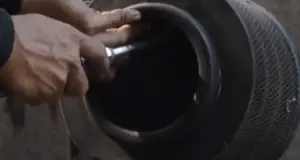A Vacuum Breaker Go On A Water Heater
Where Does A Vacuum Breaker Go On A Water Heater? An air gap acts as the most significant barrier between a potential source of contamination and the plumbing system.
It is necessary to know when to use one method of protection over another when guaranteeing this protection through mechanical measures. For this reason, we will discuss where a vacuum breaker goes on a water heater that keeps our water safe.
Vacuum Breaker On A Water Heater
Water supply protection from backflow and back-siphonage is so well understood in the plumbing community that to say they are common knowledge would be putting it mildly. It would be useful to explore the various methods of preventing backflow and back-siphonage in more detail.
An Atmospheric Vacuum Breaker
Vacuum breakers prevent back-siphonage. When the device is pressurized, an air vent and a check valve are normally closed. The air vent allows air into the piping system to stop a siphon at the point of use. The air-inlet valve and the check valve are usually the same mechanical component.
Due to the fact the AVB only protects against back siphonage, it is considered isolation protection only. It is attached to appliances and plumbing fixtures. It is not recommended to install them near the service line for a building, where there may be backpressure problems.
All vacuum breakers are consider high-hazard protection. They keep dangerous substances out of the potable water. If a backflow preventer provides high-risk protection, it will also be adequate for low-risk applications.
AVBs cannot be backpressure. The valve allows air into the system to stop a siphon with low water pressure. While the valve is close to the atmosphere, the device cannot identify which direction the water is flowing. Thus, elevate piping, auxiliary water sources, or pressure pumps, for example, are not permit downstream. AVBs should be install upright. To operate properly, the valve that allows air into downstream piping relies on gravity. The valve may not fully open if the device is instal out of plumb.
A Hose Connection Vacuum Breaker
To avoid backflow into potable water, hose connections should be equip with vacuum breakers. HVBs should be install six inches above ground level. The set screw on most HVBs makes it difficult to remove them once install. They cannot be remove when the garden hose is remove. The HVB requires no further adjustments after installation.
Backflow prevents by venting water to the atmosphere onto the ground when conditions are backflowing. The spring-loaded check valve opens when outflow occurs. The garden hose can receive water when the pressure is high enough to open the check valve.
The outflow stops when the supply pressure is interrupt or exceed, and the spring-load check valve closes, simultaneously allowing a vent to be open to the atmosphere. Any water flowing backward through the HVB is vent onto the ground.
Due to the spring-loaded check valve, water cannot drain from between the hose bibb and the upper part of the HVB, so there needs to be freeze protection, just as all outdoor plumbing needs to be protect under freezing conditions.
A Pressure Vacuum Breaker Go On A Water Heater
An AVB is a pressure-type vacuum breaker. There are several restrictions related to AVB installation. One limitation is that there can be no continuous water pressure. It is a serious issue when the inlet valve sticks closed, as it would render the AVB useless. To overcome the problem, the PVB was invented.
When there is no water pressure, the AVB acts as a check valve to the supply piping. PVB check valves are spring-loaded, but their function is similar. The spring reduces the piping-system pressure, so the check opens to the atmosphere, allowing air into the pipeline and breaking the downstream siphon.
Consequently, PVBs are designe to operate under pressure for a long period without becoming inoperable. With the internal check valves spring-load, there is no tendency for the valve to stick close due to prolong pressure application and fouling will be prevent.
A Spill Resistant Vacuum Breaker Go On A Water Heater
It is essentially a next-generation PVB. The assembly was develop as a result of spillage from PVBs. An SVB’s purpose is to prevent water spillage from the PVB.
The check valve and air inlet of the pressure vacuum breaker must function independently, but the components of the SVB need not function independently. The diaphragm at the bottom of the valve chamber allows the poppet to close before the internal check valve opens, preventing most of the spillage that occurs with a PVB. This will close the air inlet when the check is closed again, eliminating the spill. SVB provides the same kind of protection as PVB and can only be used where PVB is appropriate.
Conclusion
A vacuum breaker can play a crucial part in that effort, allowing you to maintain a high level of safety by understanding when and where to use them and how they work. Safety is the number one priority when it comes to the potable water supply that the public uses.





